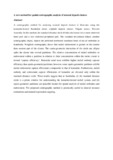Please use this identifier to cite or link to this item:
https://cris.library.msu.ac.zw//handle/11408/1672Full metadata record
| DC Field | Value | Language |
|---|---|---|
| dc.contributor.author | Mamuse, Antony | - |
| dc.contributor.author | Porwal, Alok | - |
| dc.contributor.author | Kreuzer, Oliver | - |
| dc.contributor.author | Beresford, Steve | - |
| dc.date.accessioned | 2016-07-08T12:33:29Z | - |
| dc.date.available | 2016-07-08T12:33:29Z | - |
| dc.date.issued | 2009 | - |
| dc.identifier.issn | 0169-1368 | - |
| dc.identifier.uri | https://www.researchgate.net/publication/248211962 | - |
| dc.identifier.uri | http://hdl.handle.net/11408/1672 | - |
| dc.description.abstract | A centrographic method for analysing mineral deposit clusters is illustrated using the komatiite-hosted Kambalda nickel sulphide deposit cluster, Yilgarn craton, Western Australia. In this method, the standard distance circle divides the cluster into a more endowed inner part and a less endowed peripheral part. The standard deviational ellipse, another centrographic object, depicts the preferred northwest–southeast trend of nickel orebodies at Kambalda. Weighted centrography shows that nickel endowment is greater in the eastern than western part of the cluster. The spatio-geometric interaction of the circle and ellipse splits the cluster into several partitions. The relative concentration of nickel orebodies or endowment within a partition in relation to their concentration within the entire cluster is termed ‘capture efficiency’. Komatiite areal trace exhibits higher nickel orebody capture efficiency than spatio-geometric partitions; however, some spatio-geometric partitions exhibit nickel endowment capture efficiencies comparable to that of komatiite. Furthermore, nickel orebody and endowment capture efficiencies of komatiite are elevated only within the standard distance circle. These results suggest that at Kambalda, (i) the standard distance circle is a prime window for understanding the komatiite-hosted nickel system, and (ii) spatio-geometric partitions are plausible locales for spatial analysis of nickel orebodies and endowment. The proposed centrographic method is potentially useful in mineral resource estimations and mineral exploration targeting. | en_US |
| dc.language.iso | en | en_US |
| dc.publisher | Elsevier | en_US |
| dc.relation.ispartofseries | Ore Geology Reviews;Vol. 36; p. 293–305 | - |
| dc.subject | Standard distance circle, Standard deviational ellipse, Capture efficiency | en_US |
| dc.subject | Spatio-geometric, Nickel Kambalda | en_US |
| dc.title | A new method for spatial centrographic analysis of mineral deposit clusters | en_US |
| dc.type | Article | en_US |
| item.fulltext | With Fulltext | - |
| item.languageiso639-1 | en | - |
| item.grantfulltext | open | - |
| item.cerifentitytype | Publications | - |
| item.openairetype | Article | - |
| item.openairecristype | http://purl.org/coar/resource_type/c_18cf | - |
| Appears in Collections: | Research Papers | |
Files in This Item:
| File | Description | Size | Format | |
|---|---|---|---|---|
| A new method for spatial centrographic analysis of mineral deposit clusters.pdf | Abstract | 98.88 kB | Adobe PDF |  View/Open |
Page view(s)
144
checked on Dec 3, 2025
Download(s)
24
checked on Dec 3, 2025
Google ScholarTM
Check
Items in MSUIR are protected by copyright, with all rights reserved, unless otherwise indicated.



